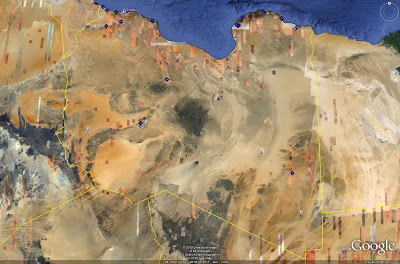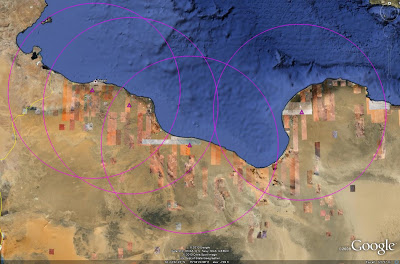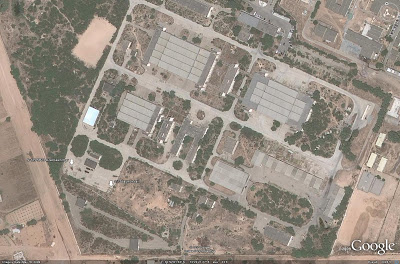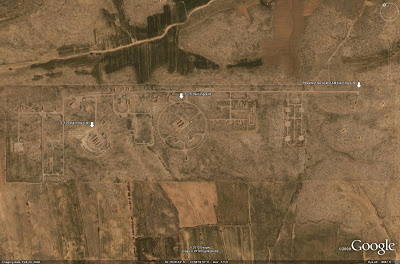يوجد لديها دفاعات جوية ( ولذلك تحديدا اضطرت امريكا لاطلاق 119 توماهوك لابادة الدفاعات الجوية .. ارجع واقرأ بعناية ردي السابق نقلا عن شهادة الفرنسيين انفسهم )
هنا موضوع متكامل لكن بالانجليزية حول الدفاعات الجوية الليبية ( S-75 (SA-2 GUIDELINE), S-125 (SA-3 GOA), and S-200 (SA-5 GAMMON)
The Libyan Air Defense System. Libya’s Surface to Air Missile (SAM) Network
By
Global Research
Global Research, March 21, 2011
IMINT & Analysis 21 March 2011
Region:
Middle East & North Africa
Theme:
Militarization and WMD
INTRODUCTION
Libya possesses one of the most robust air defense networks on the African continent, falling second only to Egypt in terms of coverage and operational systems. Libyan strategic SAM assets are primarily arrayed along the coastline, ostensibly defending the bulk of the Libyan population and preventing foreign incursion into Libyan airspace.
THE STRATEGIC SAM FORCE
Libyan strategic SAM assets are subordinate to the Air Defense Forces, which in turn are subordinate to the Libyan Air Force. Currently believed to be divided into five separate regional commands, the Air Defense Force operates a variety of Soviet-era equipment. The following strategic SAM systems are currently serving within the Libyan Air Defense Force: S-75 (SA-2 GUIDELINE), S-125 (SA-3 GOA), and S-200 (SA-5 GAMMON).
EW Coverage
Seventeen active and four inactive EW sites provide Libya’s military with early warning radar coverage, used for SAM system target acquisition and track handoff, and GCI control of fighter units. These EW sites are located primarily along the western and eastern coastal regions, monitoring the airspace around Tripoli and Benghazi. Identified EW radars operating in Libya are predominately Soviet-era systems. The following systems have been identified in available imagery:
P-12/18 (SPOON REST)
P-14 (TALL KING)
P-35/37 (BAR LOCK)
P-80 (BACK NET)
In addition, Libya is reported to have received five Italian LPD-20 air search radars in 1983 and three Soviet 5N69 (BIG BACK) EW radars between 1984 and 1985. None of these systems have been identified in available imagery, but that does not preclude their existance.
The following image depicts the locations of identified EW radar sites in Libya:

The following image depicts a notional Libyan EW site, located near Sabha in the western portion of the nation’s interior. This is representative of roughly one third of Libya’s EW sites. Five sites are only fitted with P-12/18 series radars, with five being fitted with multiple radar systems. The P-12/18 sites likely serve to bolster or extend coverage, with the five sites containing multiple EW radars possibly serving as the command centers for the aforementioned regional commands.

Some strategic SAM sites contain their own organic EW elements. This allows them to perform independent target acquisition, or to accept long-range track handoff from regional EW centers. Seven SAM sites, four S-75 and three S-200, have identified EW assets. S-75 sites feature P-12/18 radars, with S-200 sites featuring P-14 radars. No S-125 sites, and the remaining S-75 and S-200 sites, contain identified EW assets, but this is likely due to the quality of available imagery rather than a lack of assets.
The following image depicts a deployed P-12/18 EW radar at an S-75 site near Tripoli:
 SAM Coverage
SAM Coverage
There are currently thirty one active strategic SAM sites located in Libya. The following image depicts the locations of these sites. S-75 sites are red, S-125 sites are light blue, and S-200 sites are purple. As can be seen, the overwhelming majority of the deployed strategic SAM assets are located along the same coastal regions featuring the bulk of the EW assets.

The following image depicts the overall SAM coverage provided by the identified Libyan strategic SAM sites. Using the same color scheme applied previously, SA-2 zones are red, S-125 zones are light blue, and S-200 zones are purple.
 S-75
S-75
There are currently eleven active S-75 sites inside of Libya, constituting roughly one third of the strategic SAM force. Russian sources claim that thirty nine S-75M Volkhov batteries were supplied to Libya between 1974 and 1985. Other sources suggest that the initial order of eighteen batteries supplied between 1974 and 1975 consisted of S-75 Dvina systems. S-75 batteries are deployed to protect key population centers and military facilities, predominately along the coastal region.
The following image depicts the coverage provided by Libya’s active S-75 batteries:
 S-125
S-125
There are currently sixteen active S-125 sites inside of Libya. Eight batteries are situated on former S-75 sites. The S-125 represents half of the deployed strategic SAM assets in the nation. Libya operates the S-125M Neva-M variant, with thirty three batteries being supplied between 1974 and 1976. As with the S-75, S-125 batteries are deployed to protect key population and military facilities, predominately along the coastal region.
The following image depicts the coverage provided by Libya’s active S-125 batteries:
 S-200
S-200
There are currently four active S-200 sites inside of Libya, each site being equipped with two batteries. The S-200 represents the longest-range strategic SAM system in the Libyan arsenal. The proximity of these four locations to the coastline allows them to range far out into the Mediterranean, theoretically providing a significant standoff engagement capability. Six S-200 batteries were initially supplied to Libya between 1985 and 1986, with a further five being delivered in 1988. There is some confusion as to which variant Libya operates. Russian sources refer to the system delivered as the S-200VE, but the SIPRI arms trade register refers to the system as the Angara, implying that the longer-range S-200DE was delivered.
The following image depicts the coverage provided by Libya’s active S-200 batteries. A range of 300 kilometers is used, corresponding to the Angara variant.
 Tactical SAM Systems
Tactical SAM Systems
The Libyan Army operates various tactical SAM ssytems which could be called upon to provide point defense of serve as gap fillers in the overall air defense network. These systems include the 2K12 Kvadrat (SA-6 GAINFUL), 9K33 Osa (SA-8 GECKO), 9K31 Strela-1 (SA-9 GASKIN), 9K35 Strela-10 (SA-13 GOPHER), and Crotale. While the 9K33 is the most numerous system, the 2K12 represents the msot capable tactical SAM system.
Inactive Sites
There are currently thirty identified inactive strategic SAM sites located in Libya. There are fifteen S-75 sites, eleven S-125 sites, and four S-200 sites. These sites are all located within areas featuring active SAM batteries. As such, they may represent facilities available for bolstering the defenses of a given region during hostilities, drawing on equipment held in garrison, or they may represent dispersal locations for the realignment of SAM deployments over time.
To support the latter concept, it should be noted that five inactive sites, two S-75, one S-125, and two S-200, have hosted operational batteries at some point in the past. Also, three S-125 and one S-200 site currently operational were noted as being inactive at some point in the past. This suggests that there is a policy of redeployment and reorganization that occurs. Militarily this is a sound strategy, as it complicates the targeting of these facilities by a potential aggressor. While it is true that new site locations can be deduced by imagery or ELNT analysis, it adds to the workload of pre-strike planners.
The following image depicts the locations of inactive strategic SAM sites located in Libya:
 Support Facilities
Support Facilities
Eleven facilities provide logistical support for the overall strategic SAM network. Ten of these facilities are SAM garrisons housing undeployed equipment and missile reloads, with the remaining facility being a dedicated SAM training complex. Seven of the SAM garrisons are generic facilities supporting multiple systems. Based on the identification of system components in available imagery, two of the remaining SAM garrisons appear to solely support the S-75, with the remaining garrison supporting the S-125. All garrisons are located in the vicinity of prepared launch sites.
The following image depicts a combined S-75/125 garrison complex near Tripoli:

The following image depicts the Libyan SAM training complex near Misratah:
 STRATEGIC SAM FORCE CAPABILITY
STRATEGIC SAM FORCE CAPABILITY
Libyan strategic SAM assets are arranged to provide a layered air defense zone with overlapping fields of fire. S-75 and S-125 batteries are located in close proximity to provide both redundancy and support, with the S-125 being more capable at lower altitudes than the S-75. The large number of inactive sites suggests that the force has been drawn down over time. This could be due to service life issues, equipment failure, financial reasons, or the expenditure of missile stocks.
National S-200 Coverage
The first line of defense in Libya’s strategic SAM network is the S-200. Positioned along the coastline, the four active S-200 batteries provide a credible deterrent to high-RCS cooperative targets such as ISR platforms. S-200 batteries are located near Tripoli, Misratah, Surt, and Benghazi.
Coastal Coverage
Libya’s S-75 and S-125 sites are concentrated primarily along the western and eastern coastlines. While the S-200 batteries are situated to provide barrier air defense of the nation’s coastline, the S-75 and S-125 sites are positioned to provide point defense of assigned areas. From west to east, these sites are arrayed around Ibn Nafa airbase, Tripoli, Misratah, Benghazi, Bombah, and Adam. While contiguous coverage of the coastal region is not provided by these sites, each location is defended by no fewer than three batteries. Ibn Nafa and Bombah are defended by one S-75 and two S-125 batteries, Misratah is defended by one S-75 and three S-125 batteries, and Benghazi and Adam are defended by two S-75 and two S-125 batteries.
The following image depicts the coastal coverage of Libya’s S-75 and S-125 batteries, with the locations of the S-200 batteries also marked:

Interestingly, while Surt features an active S-200 battery, all S-75 and S-125 sites in the area are currently inactive. This leaves the coastline along the Gulf of Sidra relatively undefended.
The most heavily defended city is the capitol of Tripoli. Tripoli is defended by three S-75 and four S-125 batteries, with an S-200 battery positioned south of the city. Three SAM garrisons and three EW facilities are also present in the area, as are four inactive SAM sites.
The following image depicts SAM-related facilities and coverage zones near Tripoli:

The following images depict SAM-related facilities and coverage zones near the remaining coastal areas.
Ibn Nafa Airbase

Misratah

Benghazi

Bombah

Adam
 Inland Coverage
Inland Coverage
Sabha is the only inland city within Libya to have any strategic SAM defenses. Much of the Libyan interior is sparsely populated, as are the regions it borders. What then makes Sabha stand out as a location requiring SAM defenses? First, Sabha is believed to have been associated with the defunct Libyan nuclear weapons program. Second, Sabha was home to Libyan rocket development in the early 1980s, when the OTRAG rocket was tested from the Seba Oasis launch facility. There remains a significant military presence in the area, which is likely the ultimate reason for the presence of strategic SAM assets and related support facilities.
The following image depicts SAM-related facilities and coverage zones near Sebha:
 Air Defense Issues
Air Defense Issues
Libya’s strategic SAM network is logically arrayed to defend key facilities following a point defense strategy, with long-range S-200 systems providing standoff barrier air defense along the coastal region. However, Libya’s strategic SAM network has many flaws.
The main drawback of the Libyan strategic SAM network is an overreliance on aging Soviet technology. Russian manufacturers presently produce what are arguably the most advanced and capable land-based strategic SAM systems in the world. Much of their success lies in the fact that they have produced a diverse array of SAM systems with numerous variants. However, this history also presents a problem for nations relying on older technology: the rest of the world has simply passed them by. Advances in electronic warfare and ECM have made many of the older Soviet-era SAM systems obsolete in a modern air combat environment. Libya’s S-75, S-125, and S-200 systems are no exception. Furthermore, despite some claims to the contrary, the Libyan strategic SAM force was generally ineffective during hostilities with the United States in the mid 1980s.
In one case, Soviet military officials deduced that the S-200 succeeded in downing three US Navy aircraft in March of 1986, based only on the perception of fragments on the radar readouts and the presence of helicopter activity in the area, the latter being attributed to CSAR efforts. The USN has never disclosed any aircraft losses during the incident, which in and of itself does not indicate that no aircraft were lost, but the other two pieces of “evidence” can easily be explained. The apparent appearance of aircraft fragments on the radar operators’ screens could have been attributed to chaff dispersal or radar interference, especially if the aircraft descended below the radar’s field of view. Also, helicopter activity is not limited to CSAR operations in the USN; helicopters active at the time could have been performing anti-submarine patrols, searching out and identifying surface contacts, or simply flying proiciency sorties. Whatever the case may be, the evidence does not conclusively indicate that any USN aircraft were downed by S-200s, and if the Russians or Libyans have any evidence to the contrary they have certainly never seen fit to bring it into the open.
Later in 1986, the Libyan strategic SAM network was abused during Operation ELDORADO CANYON, the US military response to Libyan support of terrorism. Lieutenant General Vladimir Yaroshenko, a former officer in the Soviet PVO SAM Troops, was assigned to analyze the poor performance of the Soviet supplied SAM systems in that operation. LTG Yaroshenko has reported his discovery that poor command and control, poor radar coverage, and a lack of appreciation for American anti-radar weapons and tactics precluded effective target engagement. One interesting fact which he mentions is that the S-75 batteries had a minimum engagement altitude of 100 meters, corresponding to the S-75M Volkhov system as mentioned previously. He also confirms that only one US aircraft, an F-111 shot down by AAA fire, was lost, despite Venikian levels of propaganda claiming otherwise at the time.
Part of the current problem stems from international sanctions placed on Libya during the 1980s which effectively stifled any serious chances of upgrading or replacing obsolete systems. The rest of the problem lies in the systems themselves. All three strategic SAM types operated by Libya have been thoroughly exploited by Western intelligence agencies, and many Western nations have faced these same systems in combat at various times, allowing for continued refinement of ECM systems designed to defeat these weapons electronically. Also, no strategic SAM system operated by Libya possesses a multi-target engagement capability. The only SAM sites representing a threat to multiple aircraft are the S-200 locations, as they possess multiple 5N62 (SQUARE PAIR) engagement radars. As such, even though Libyan strategic SAM sites are arrayed to provide overlapping fields of fire while defending a given area, the relatively small number of sites represents a threat to only a small number of targets. As a result, the overall network is easily susceptible to oversaturation.
The second drawback to Libya’s strategic SAM network is one of layout. If it is accepted that older Soviet-era systems may still be reliable against regional aggressors lacking modern, sophisticated EW or ECM suites, the system still has a significant number of gaps that could be exploited. The S-200 represents the only significant over water threat, but is constrained by having a minimum engagement altitude of 300 meters. Any terrain-hugging aircraft or cruise missiles would easily be able to exploit this weakness to approach the Libyan coastline. Once the coastline has been reached, the most obvious point of ingress would be the area adjacent to the Gulf of Sidra, which is devoid of deployed strategic SAM assets. Furthermore, as evidenced in the image seen previously, there are gaps between areas covered by S-75 and S-125 batteries which could also be exploited. This does not of course take into account the presence or performance of interceptors, AAA, or tactical SAM units, as these systems are outside the scope of this analysis.
CONCLUSION
At the end of the day, the Libyan strategic SAM network requires a massive infusion of new technology to remain viable in the twenty first century. It was not capable of repelling an attack over twenty years ago, and there is no reason to suspect that it will be capable of such action today. Libya is reportedly negotiating for the purchase of advanced S-300PMU-2 (SA-20B GARGOYLE) SAM systems from Russia, which would go a long way towards modernizing the network and restoring its effectiveness. Colonel al-Gaddafi has made great strides in bringing Libya back into the community of nations, and deserves a large amount of praise for doing so, but that should not lessen the Libyan government’s desire or responsibility to provide adequate defense for its citizens.
SOURCES
-The aforementioned data is based on analysis of the available open-source satellite imagery of Libya and may therefore not represent the entire air defense network.
-Satellite imagery provided courtesy of Google Earth
SIPRI
The North African Military Balance: Force Developments in the Maghreb (PDF File)
The OTRAG rocket
Jane’s Land-based Air Defence, various editions
SAMs of the PVO, Mikhail Pervov, 2001
Fakel’s Missiles, Vladimir Korovin, 2003
The original source of this article is
IMINT & Analysis
Copyright ©
Global Research,
IMINT & Analysis, 2011
http://www.globalresearch.ca/the-li...ya-s-surface-to-air-missile-sam-network/23841
























